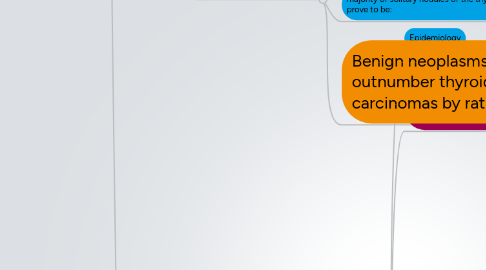
1. Carcinoma of the thyroid
1.1. Epidemiology
1.1.1. mostly in adult although some forms " papillary carcinoma" may present in children.
1.1.2. 1.5% of all cancers
1.2. enviromental factors
1.2.1. the mjor risk factor presidposing to thyroid cancer is exposure to ionizing radation.
1.3. Subtyoes:
1.3.1. Papillary carcinoma
1.3.1.1. > 85% of cases
1.3.1.1.1. MOST COMMON THYROID CANCER
1.3.1.2. Genetic:
1.3.1.2.1. a- Rearrangments of tyrosin kinase receptor RET of NTRK1.
1.3.1.2.2. b- activating point mutation in BRAF
1.3.1.2.3. c- RAS mutation ( 10 - 20 % of papillary carcinomas )
1.3.1.3. Epidemiology
1.3.1.3.1. mostly between 25 and 50 Y/O
1.3.1.3.2. majority assiciated with exposure of ionizing radation.
1.3.1.3.3. incidence increase markedly in the last 30 years
1.3.1.4. morphology
1.3.1.4.1. Solitary or multifocal lesions
1.3.1.4.2. Papillary structure
1.3.1.4.3. psudo-inclusions
1.3.1.4.4. orphan Annie nuclei
1.3.1.4.5. psammoma bodies
1.3.1.4.6. Grooved nuclei
1.3.1.5. varients
1.3.1.5.1. many
1.3.1.6. Clonical course
1.3.1.6.1. Mostly asymptomatic thyroid nodule
1.3.1.6.2. 1st manifesation may be a mass in a Cervical lymph nodes
1.3.1.6.3. have excellent prognosis
1.3.2. Follicular carcinoma
1.3.2.1. 5 - 15 % of cases
1.3.2.2. Genetic:
1.3.2.2.1. Mutation in RAS ( oncogenes )
1.3.2.2.2. mnemonic: follicular = round shape & راس = round shape = RAS
1.3.2.3. Epidemiology:
1.3.2.3.1. more common in women (3:1)
1.3.2.3.2. peak incidence between 40 & 60
1.3.2.3.3. more in areas with iodine deficiency
1.3.2.4. types
1.3.2.4.1. minimaly invasive
1.3.2.4.2. widely invasive
1.3.2.5. Morphology
1.3.2.6. 431 Team:it looks like Follicular adenoma but With the presnce of either:1- Vascular invasion 2- Capsular invasiom
1.3.3. Medullary carcinoma
1.3.3.1. 5% of caes
1.3.3.2. Genetic:
1.3.3.2.1. familial medullary thyroid carcinomas occur in multiple endocrine neoplasm type 2 (MEN-2) RET proto-oncogene mutation
1.3.3.3. origin
1.3.3.3.1. neuroendicrine neoplasm derived from parafollicular cells , C cells , of the thyroid
1.3.3.4. features:
1.3.3.4.1. similar to normal C cells, secrete calcitonin, the measurement of it plays important role in the diagnosis & post-operative follow-up
1.3.3.4.2. 70% sporadic
1.3.3.4.3. 30% occurs in setting of MEN syndrome 2A or 2B or as familial tumor without an associated MEN syndrome (Fmailial medullary thyroid carcinoma, FMTC)
1.3.3.5. Morphology:
1.3.3.5.1. polygonal to spindle cells
1.3.3.5.2. Amyloid deposition
1.3.3.5.3. Bilaterality
1.3.3.5.4. Multicentricity
1.3.3.5.5. necrosis
1.3.3.5.6. Hemorrhage
1.3.3.6. Stains
1.3.3.6.1. ImmunoHistoChemistry (IHC) stain for calcitonin
1.3.3.6.2. Congo Red stain for Amyloid
1.3.4. Anaplasic (undifferentiated) carcinoma
1.3.4.1. < 5% of cases
1.3.4.1.1. the least common & the most dangerous
1.3.4.2. genetic:
1.3.4.2.1. inactivating point mutations in the p53 "tumor suppressor gene" Rare in well differntiated thyroid carcinoma BUT common in anaplstic tumors.
1.3.4.3. lethal (100%)
1.3.4.4. in older age group > 65 year
1.3.4.5. morphology
1.3.4.5.1. Highly anaplastic cells
1.3.4.5.2. show all types of morphologic anaplasia
1.3.4.6. origin
1.3.4.6.1. undifferntiated tumor of thyroid follicular epithelium
1.3.4.6.2. can be arising from a more differentiated carcinoma (papillary)
2. How to distiguish follicular adenomas from follicular carcinomas?
2.1. Follicular Adenoma
2.1.1. resemble normal thyroid follicles, similar to each other & encapsulated
2.2. Follicular carcinoma
2.2.1. Capsular or vascular invasion
3. Cold & Hot nodules?
3.1. Cold nodules
3.1.1. Do NOT take up radioactive iodine
3.1.2. 10% are malignant !!!
3.2. Hot nodules
3.2.1. All are benign
3.2.2. functional nodules that take up radioactive iodine in imaging studies.
4. Adenoma (Follicular adenoma)
4.1. discrete solitary mass ( follicular adenoma )
4.2. Painless nodules
4.3. larger masses may produce local symptoms
4.3.1. such as diffculty in swallowing
4.4. appear as cold nodule relative to adjacent normal thyroid gland
4.5. however, Toxic adenoma will appear as "Warm" or " Hot" nodules in the scan
4.6. 10% of cold nodule are malignant
4.7. Diffinitive diagnosis of thyroid adenoma can only be made after careful histological examination of resected specimen
4.8. Thyroid adenomas have excellent prognosis & do not recur or metastasize
5. Solitary thyroid nodule
5.1. palpable discrete swelling within an otherwise apparently normal thyroid gland
5.2. Epidemiology
5.2.1. incidence in US in adult 1-10 %
5.2.2. single nodules 4 times more in women
5.2.2.1. all thyroid neoplasms are common in female.
5.2.3. the incidence increase with age
5.3. majority of solitary nodules of the thyroid prove to be:
5.3.1. localized
5.3.2. non-neoplasitcn or benign neoplasm such as follicular adenoma

